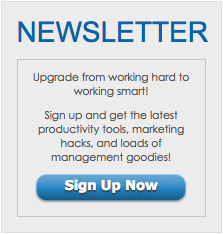Productivity is a challenge for almost every business. Though some interruptions are unavoidable, many workplaces have tasks and obstacles preventing employees from most effectively navigating their work day.
Your workers are also human beings with personal struggles and challenges that sometimes prevent them from working at their best. Without support, their productivity obstacles become greater.
There are ways for your small business to conquer these challenges. If you’re calculating a productivity loss, here’s how business owners should encourage productivity growth.
Set Goals
If you want to improve your productivity, the first step is to set productivity goals of how much more you’d like to accomplish by a specific date. These are essential for change because they motivate staff to work to complete the task. It also gives them specifics about what you want to achieve instead of leaving them wondering how to move forward.
Depending on your needs, you can set both short-term and long-term goals. Short-term goals take anywhere from three months to two years to achieve, while long-term ones can take up to five to 10 years to accomplish.
Post your team goals on a wall in the shop or keep them pinned in a management app so you and your employees can reference them. You should review them regularly with your team and mention the progress made in achieving them. Once you’ve set your goals, you can then focus on taking steps to reach them.
Reduce Time-Wasting Activities
You might not realize there are two big culprits of wasting time at an office — meetings and emails. Meetings in the middle of the day slow down everything. Not only are your workers stopping their physical work, but they will also likely be distracted by an upcoming meeting. An occasional huddle can be necessary to review goals, discuss changes or celebrate major accomplishments. However, many don’t need to happen.
Emails and work bulletins are less invasive to the work day and give your employees information they can reference repeatedly. Before you set up a meeting, consider whether you can communicate the information in another way, such as an email or direct message. Constant interruptions are just one of the factors that can significantly hinder productivity.
Speaking of emails, another time-wasting activity is staff waiting for you or a co-worker to answer an urgent one. When a person stops a project because they have a question on how to proceed or need an item they don’t have, the instinct can be to email them professionally. However, it can take time for the other person to check their email and notice it, further delaying the project.
A way to reduce this problem is to set up an office-wide instant messaging server. In these, employees can message each other individually or in different groups to keep communication flowing and quickly alert each other about potential problems.
Be Flexible
Your instinct when improving productivity can be to make stricter policies and work schedules. However, you should do the opposite. Research shows providing flexible hours and hybrid work options reduces stress and improves productivity. When you offer flexibility, you remove the temptation for staff to come in sick or not take the breaks they need for their mental health. These things can lead to burnout, which can bleed over to your other employees.
Encourage people to take breaks when they need to instead of trying to power through when they’re feeling unmotivated or stressed. Promote a culture where employees work with each to ensure your business has sufficient coverage while someone grabs some food, takes a walk or even gives their eyes a break from screens. These worker-dictated systems take away the task of scheduling breaks and allow them to step out when needed.
Offering flexibility when possible lets your employees focus on getting things done and nothing else. They’ll know you care about their well-being and can come to you about anything they need to do the job most effectively without compromising their physical or mental health.
Have One-On-One Meetings
As much as you need to communicate with your employees openly, you should also be proactive about talking with them individually. The meeting should discuss how they’ve been doing in their role and any concerns about their tasks, their schedule or how things in their personal life affect their productivity.
These meetings are fantastic opportunities to get to know your staff and make unique adjustments to get the very best out of everyone working for you. You should hold these talks at least once every quarter, but monthly discussions can help keep up with your employees’ needs. Regular check-ins can remove an employee’s anxiety about meeting with an employer.
Discourage Multitasking
It might seem like multitasking helps things get done more efficiently. In most cases, it actually slows down progress by keeping employees from focusing on each task.
When workers focus on one task, their minds won’t get as distracted by other things. They can more productively complete the item at hand, producing better results quicker than if they were working on more than one thing at a time. You can do this by fairly allocating tasks to finish at different times throughout the day. Ensure enough spare time to check emails and do small office tasks.
Encouraging Productivity
As a business owner, you want to grow and satisfy your customers as much as possible. You must also make sure your employees are happy and healthy while staying on-task and productive. By encouraging productivity growth, you can do more with your company and help it — and your workforce — thrive.
Eleanor Hecks is editor-in-chief at Designerly Magazine. She was the creative director at a digital marketing agency before becoming a full-time freelance designer. Eleanor lives in Philly with her husband and pup, Bear.






